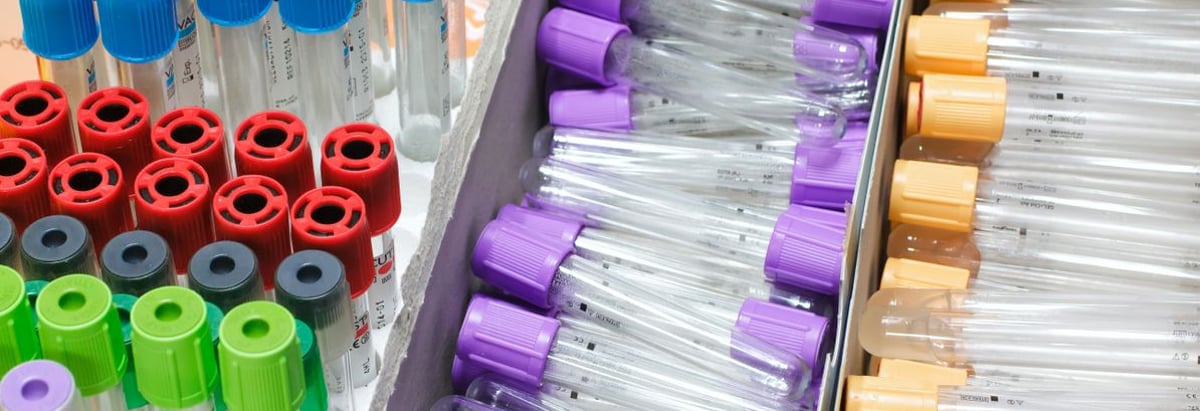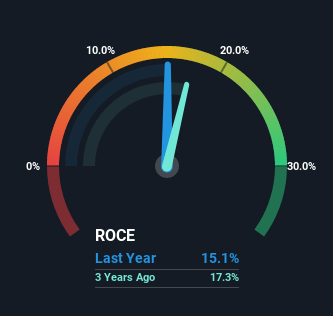- United States
- /
- Medical Equipment
- /
- NasdaqGS:ATRI
Atrion (NASDAQ:ATRI) May Have Issues Allocating Its Capital

There are a few key trends to look for if we want to identify the next multi-bagger. Typically, we'll want to notice a trend of growing return on capital employed (ROCE) and alongside that, an expanding base of capital employed. Ultimately, this demonstrates that it's a business that is reinvesting profits at increasing rates of return. Having said that, from a first glance at Atrion (NASDAQ:ATRI) we aren't jumping out of our chairs at how returns are trending, but let's have a deeper look.
Understanding Return On Capital Employed (ROCE)
For those that aren't sure what ROCE is, it measures the amount of pre-tax profits a company can generate from the capital employed in its business. Analysts use this formula to calculate it for Atrion:
Return on Capital Employed = Earnings Before Interest and Tax (EBIT) ÷ (Total Assets - Current Liabilities)
0.15 = US$39m ÷ (US$275m - US$19m) (Based on the trailing twelve months to June 2022).
Thus, Atrion has an ROCE of 15%. In absolute terms, that's a satisfactory return, but compared to the Medical Equipment industry average of 9.3% it's much better.
View our latest analysis for Atrion

Historical performance is a great place to start when researching a stock so above you can see the gauge for Atrion's ROCE against it's prior returns. If you're interested in investigating Atrion's past further, check out this free graph of past earnings, revenue and cash flow.
What Can We Tell From Atrion's ROCE Trend?
On the surface, the trend of ROCE at Atrion doesn't inspire confidence. To be more specific, ROCE has fallen from 22% over the last five years. Although, given both revenue and the amount of assets employed in the business have increased, it could suggest the company is investing in growth, and the extra capital has led to a short-term reduction in ROCE. And if the increased capital generates additional returns, the business, and thus shareholders, will benefit in the long run.
The Key Takeaway
Even though returns on capital have fallen in the short term, we find it promising that revenue and capital employed have both increased for Atrion. However, total returns to shareholders over the last five years have been flat, which could indicate these growth trends potentially aren't accounted for yet by investors. As a result, we'd recommend researching this stock further to uncover what other fundamentals of the business can show us.
On a separate note, we've found 1 warning sign for Atrion you'll probably want to know about.
For those who like to invest in solid companies, check out this free list of companies with solid balance sheets and high returns on equity.
If you're looking to trade Atrion, open an account with the lowest-cost platform trusted by professionals, Interactive Brokers.
With clients in over 200 countries and territories, and access to 160 markets, IBKR lets you trade stocks, options, futures, forex, bonds and funds from a single integrated account.
Enjoy no hidden fees, no account minimums, and FX conversion rates as low as 0.03%, far better than what most brokers offer.
Sponsored ContentNew: Manage All Your Stock Portfolios in One Place
We've created the ultimate portfolio companion for stock investors, and it's free.
• Connect an unlimited number of Portfolios and see your total in one currency
• Be alerted to new Warning Signs or Risks via email or mobile
• Track the Fair Value of your stocks
Have feedback on this article? Concerned about the content? Get in touch with us directly. Alternatively, email editorial-team (at) simplywallst.com.
This article by Simply Wall St is general in nature. We provide commentary based on historical data and analyst forecasts only using an unbiased methodology and our articles are not intended to be financial advice. It does not constitute a recommendation to buy or sell any stock, and does not take account of your objectives, or your financial situation. We aim to bring you long-term focused analysis driven by fundamental data. Note that our analysis may not factor in the latest price-sensitive company announcements or qualitative material. Simply Wall St has no position in any stocks mentioned.
About NasdaqGS:ATRI
Atrion
Develops, manufactures, and sells products for fluid delivery, cardiovascular, and ophthalmic applications in the United States, Canada, Europe, and internationally.
Flawless balance sheet average dividend payer.
Market Insights
Community Narratives



